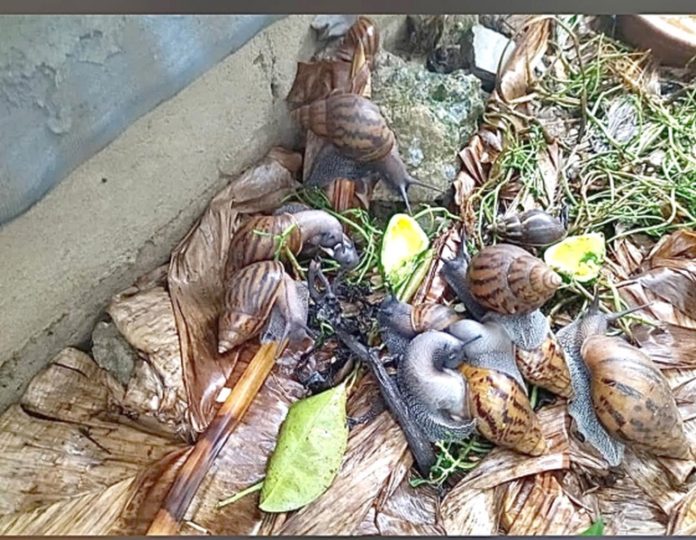Snail farmers, traders and chop bar operators have attributed the high prices of snails, a popular delicacy, to several factors, including slow growth.
Other factors they mentioned were the few farmers, limited demand, difficult hunting techniques and transportation cost.
The owner of Green Earth Snail Farm at Darkuman, Accra , Ms Juliana Nyamesah, in an interview with The Mirror in Accra last week ,said “a snail that is ready for sale would have taken up to two years to grow. Yes, they grow as slow as they crawl.”

She noted that feeding snails with leaves, vegetables and fruits could cost a farmer up to GH¢ 5 per snail daily, making it quite costly depending on the number of snails being bred.
In local food eateries, popularly called ‘chop bars’, a cooked snail often in ‘green soup’ with fufu can cost between GH¢ 30 and GH¢ 60.
In separate interviews, two chop bar operators attributed the high price to the scarcity of snails, supplier costs, transportation and preparation.
“It can cost up to GH¢ 20 to buy one large snail. If I purchase 50, that is GH¢1,000. I also have to consider transportation, employee wages, and other costs. Sometimes, I cannot even find them to buy because there are not enough suppliers, and as you know, when supply is low, prices go up,” explained Mr Kofi Fosu of Mukase Taste in Adenta, Accra.

He added that to prepare snails for consumption, Its shell needed to be cracked and the snail thoroughly cleaned with salt and lime in order to remove all of its slime, and all that demanded labour and logistics.
Our reporter visited the Madina and Makola markets in Accra for more information.
At the Madina market, it took nearly 40 minutes of walking to find snails for sale. In the entire market, only two women sold snails, and the snails on their trays were few.
One of the traders, Mrs Aba Ansah, was selling eight small snails for GH¢ 20 each. She explained that she got hers from Suhum in the Eastern Region.

“Sometimes, I handpick them from the bushes, especially during the rainy season, and also from the ground of some cemeteries,” she said.
The reason her prices were lower, Mrs Ansah explained, was because she gathered the snails herself in her hometown, which kept her cost down.
At the Makola market, scarcity was also a problem but sizes were bigger and cost GH¢ 70 for three. A trader who introduced herself as Dunquah Maame said she obtained her snails from a local farmer.
She also added that snails were a healthier alternative to other meats since they were low in fat and cholesterol, hence, their price. Read on, as we explore the business of snail farming.
Farming
Ms Nyamesah who has been in snail farming for eight years, started with 2,000 snails which were about one-year-old. Now, she has over 5,000 snails, having sold and resold matured ones.
“I sell some when they are at least a year and a half to other people who want to start snail farming. This way, I earn my money faster,” she explained.

When asked why she chose snail farming, she said it was to supplement her formal job. After researching various options, she found snail farming and sought guidance. “The rest is history,” she said.
Ms Nyamesah grows two common species: Achatina achatina and Achatina fulica, which are relatively easy to breed and require low maintenance.
She noted that snails could be bred in simple enclosures made from local materials such as wood and wire mesh.
However, she observed that their slow growth was a challenge as well as the risk of predators or humans trampling on them due to their soft shells.
Despite these challenges, she emphasised that snails did not require much water, produced little waste, and could be bred on small plots of land, making them ideal for farmers with limited space or resources.
Feeding and Maintenance
Our reporter also spoke to the owner of Desmasko Farms, Mr Desmond Adomako, He explained that feeding snails was straightforward and could be relatively inexpensive, depending on the number of snails.
“They can eat readily available food even the ones often considered waste in traditional farming,” Mr Adomako said.
“I give my snails plantain leaves, bananas, cabbages and cassava leaves. To help them grow bigger and healthier, I add powdered eggshells and peanut skins, which contain calcium for shell growth.”
Profits margins
On profit, the farmers indicated that snail farming could be profitable but it required patience and another source of income.
Ms Nyamesah mentioned that she sold each mature snail for GH¢ 15, which allowed her to earn a substantial income, though it was not consistent.
Mr Adomako, who has been farming for over 10 years, stated that he made about GH¢ 600 weekly, particularly during the rainy seasons when snails were plentiful.
Both farmers also added that they offered training at a fee, adding to their income and advised that it was best done on a large scale.
Challenges in Snail Farming
Despite its benefits, snail farming is not without challenges. Mr Adomako pointed out that snails were sensitive to temperature and humidity, which could be a problem during the dry season.
“During Harmattan, the air is too dry, and the snails don’t grow quickly.

We often have to be sprinkling water on them, or cover their location with leaves to retain moisture but these methods require extra effort,” he explained.
Mr Adomako also confirmed the problem of predators such as birds, rats and insects which could pose a threat to snails, potentially causing deaths.
In addition, they said the market for snails in the country was relatively small compared to other protein sources, making profit margins not to be high.
Minister justifies why week-old company was awarded 5G contract


